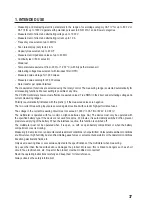
43
b) Rotary control (4)
The individual measuring functions are selected via a rotary control. The
automatic range selection “AUTO” is active for some measuring functions.
The appropriate measurement range is set individually for each applica-
tion. Always start current measurements at the highest measurement
range (10 A) and switch down to lower ranges if necessary. If the multim-
eter switch is set to “OFF”, the meter is switched off. Always turn the meter
off when it is not in use. The figure shows the measuring function layout.
7. PERFORMANCE OF MEASUREMENTS
Do not exceed the maximum permitted input values.
Do not touch any circuits or parts of circuits if they may be subject to voltages higher than 25 V/ACrms
or 35 V/DC! Danger to life!
Before measuring, check the connected measuring lines for damage such as, for example, cuts,
cracks or squeezing. Defective measuring lines must no longer be used! Danger to life!
During measuring, do not grip beyond the tangible grip range markings present on the measuring
prods.
Only the two measuring lines that are required for measuring operation must be connected to the
meter at any time. Remove all measuring lines not required from the meter for safety reasons.
Measurements in electrical circuits >50 V/AC and >75 V/DC must only be carried out by specialists
and technically instructed personnel who are familiar with the relevant regulations and the ensuing
risks.
If “OL” (overload) appears on the display, you have exceeded the measuring range.
a) Switching on the multimeter
The multimeter can be turned on and off using the rotary control. Turn the rotary control (4) to the corresponding
measurement function. To switch off, turn the rotary control to “OFF”. Always turn the meter off when it is not in use.
Before working with the meter, you have to insert the enclosed battery. Insertion and changing of
the battery is described in the chapter “Cleaning and maintenance”.
















































